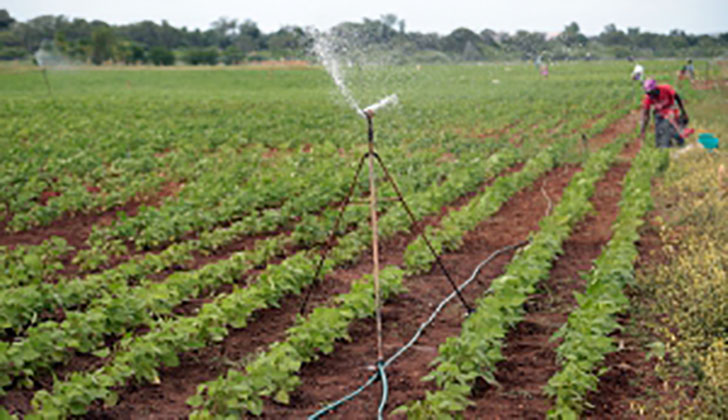by Elijah Chihota
Zimbabwe’s economy is hinged on agriculture which feeds a number of downstream industries that process agricultural produce into various foods for both humans and livestock.
The revival of this sector, which has been on a downward trend for some time, calls for some serious thinking and putting the shoulder to the wheel on the part of everyone.
Recently the country rebased its economy which saw the Gross Domestic Product (GDP) improving significantly. The GDP rose from US$18 billion to US$25.8 billion.
Given this position, how would the country use leverage on agricultural production in reviving the economy. Agriculture is such a powerful sector which feeds into other sectors and thereby creating employment and widening the tax base.
Presenting the Transitional Stabilisation Programme (TSP) October 2018–December 2020, Minister of Finance and Economic Development, Prof Mthuli Ncube said, “With respect to agriculture, the Programme presents quick win investment opportunities for realisation of self- sufficiency and food surpluses that will see the re-emergence of Zimbabwe as a major contributor to agricultural production and regional food security in the Southern Africa region and beyond.”
During the then Southern Africa Development Co-ordinating Committee (SADCC), the predecessor to SADC, Zimbabwe was assigned to the food security portfolio as the country was renowned for producing high quality food in abundance.
Right now the nation needs about 450 000 tonnes of wheat per annum. Wheat production in Zimbabwe reached its peak in 2001 when 325 000 tonnes were harvested. After that, production was on a downward trend. In order to revive wheat production, farmers need both financial and technical expertise to improve their yields which are currently as low as 1.5 tonnes per hectare. Agriseeds Sales and Marketing Director, Ivan Craig, pointed out to serious wheat that they need to realise yield of at least 6 tonnes per hectare for a successful enterprise.
Regarding soya beans, the country needs 400 000 tonnes to produce adequate edible oil. Current production levels are at 60 000 tonnes and the shortfall is catered for through importation of crude cooking oil mainly from South Africa. Other by-products from soya beans include soya milk, soya chunks and soya cake for stock feeds. It therefore means that if more soya beans are grown to satisfy the local market, the by-products would also feed into downstream industries. United Refineries Limited (URL) Chief Executive Officer, Busisa Moyo, posted on his Twitter handle @Busisa74, “Let’s get our arguments on food products correctly. Our real problem is not a shortage of foreign currency. It’s low productivity in Agriculture. Last year 60,000mt vs. 400,000mt installed capacity. Foreign currency is needed when you haven’t grown but want to still eat and enjoy.”
Milk requirements for the nation stood at 120 million litres annually, of which the national dairy production was 67 million litres in 2017. The Zimbabwe Association of Dairy Farmers (ZADF), in its Strategic Plan (2018–2022) plans to grow production to 131 million litres. The industry suffered a setback when the number of dairy cows dropped from 122 000 in the 1990s to 28 000. The nation imports 60% of its milk requirements.
During a SAPES Trust public dialogue held on 4 October 2018, Confederation of Zimbabwe Industries (CZI) President, Sifelani Jabangwe, pointed out that peanut butter was produced locally, but using 90 percent imported groundnuts. On the other hand, a lot of rural women grow a lot of groundnuts which are not even delivered to the Grain Marketing Board (GMB).
Given the above scenarios that are affecting the Zimbabwe agricultural sector, there is need for intervention.
Industries which use these agricultural produce as raw materials should work out a mechanism which enables them to fund farming activities similar to contract farming used in tobacco growing. This may entail the re-introduction of the Zimbabwe Agricultural Commodities Exchange (ZIMACE) to offer competitive prices which in turn stimulate higher production on farms.
Prof Ncube went on to say, “The Transitional Stabilisation Programme envisages greater involvement of the domestic financial system in underpinning the financing of agriculture.” Banks should now rise to the occasion and work out financing models for farmers to boost production which would create excess for export given that the country needs foreign currency to import essential commodities such as fuel and pharmaceutical products.
Universities which offer courses in animal science should also partner farmers in improving their cattle breeds for both domestic and export markets. Equally these institutes of higher learning may chip in the establishment of drip irrigation in order to maximise on the perennial water bodies dotted around the country. This is also where the expertise of Israelis would come in given that they have more than 60 years’ experience using drip irrigation.
Modern farming tends to be more mechanised and therefore, farmers need to seek partnership with technical experts and make sure that they use efficient machinery. When Israeli Ambassador to Zimbabwe, Mr Gershon Kedar, visited the country, he noted that, “I am in discussions with the private sector (in Israel) as well, of course there are various companies here (which are) already working in various areas. I think as the Government addresses the economic situation here together with the assistance of international financial institutions, many Israeli companies would want to come here. We are in discussions and it will take some time, but I think there would be a lot of companies especially in areas such as agriculture, water, high-tech and communication that are showing interest and I think they would be setting shop here as soon as possible.”




